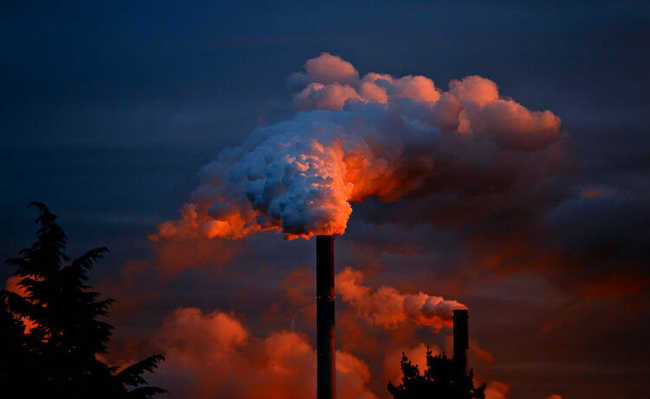What is the greenhouse effect?
Greenhouse effect is essential for human existence. But global warming increases

Luke Pamer image in Unsplash
The greenhouse effect is an important process for the existence of life on Earth as we know it. Without it, the planet's average temperature would be around minus 18°C. For comparison purposes, the global average temperature near the surface is 14°C. If we are alive today, it is due to the greenhouse effect, which keeps the planet habitable. In the greenhouse effect, the solar radiation that reaches the atmosphere interacts with the gases present there. In this interaction, the so-called greenhouse gases (GHG) absorb solar radiation and start to emit infrared radiation, or, better said, heat, back to the Earth's surface. Only part of this heat (infrared radiation) makes it out of the atmosphere and back into space - and that's how the Earth manages to maintain its temperature.
Some examples of these gases that interact with solar radiation are carbon dioxide (CO2), methane (CH4), nitrous oxide (N2O) and the family of CFCs (CFxCly). Learn more about them in the article: "What are greenhouse gases".
In the video below, produced by a partnership between the Brazilian Space Agency and the National Institute for Space Research, you can better understand how the greenhouse effect takes place:The global average temperature remains practically unchanged when the balance of the amount of incident solar energy and reflected energy in the form of heat is balanced. However, this balance can be destabilized in several ways: by changing the amount of energy reaching the earth's surface; by the change in the orbit of the Earth or the Sun itself; by the change in the amount of energy that reaches the Earth's surface and is reflected back to space, due to the presence of clouds or particles in the atmosphere (also called aerosols, which result from burning, for example); and by the change in the amount of longer wavelength energy reflected back into space due to changes in the concentration of greenhouse gases in the atmosphere.
Greenhouse gases
Greenhouse gases are those that interact with solar radiation and contribute to the greenhouse effect. Carbon dioxide (CO2), methane gas (CH4), nitrous oxide (N2O), ozone (O3) are among the main greenhouse gases. However, the Kyoto Protocol also includes sulfur hexafluoride (SF6) and two families of gases as important for the greenhouse effect: the hydrofluorocarbons (HFC) and the perfluorocarbons (PFC).
- CO2 is the most abundant greenhouse gas. It is significantly emitted through human activities that involve burning fossil fuels (oil, coal and natural gas) and deforestation. Since the Industrial Revolution, the amount of CO2 in the atmosphere has increased by 35%. And currently, it is considered to be responsible for 55% of the world's greenhouse gas emissions.
- Methane gas is a GHG 21 times stronger than CO2. Human-derived emissions of this gas result mainly from livestock activities and the decomposition of organic matter from landfills, dumps and hydroelectric reservoirs.
- Nitrous oxide is a GHG 310 times more powerful than CO2. The anthropogenic emission of this gas results from the treatment of animal waste, the use of fertilizers, the burning of fossil fuels and some industrial processes.
- Ozone is found naturally in the stratosphere (atmospheric layer located between 11 km and 50 km altitude), but can originate in the troposphere (atmospheric layer located between 10 km and 12 km altitude) by the reaction between polluting gases emitted by human activities. In the stratosphere, ozone forms a layer that has the important function of absorbing solar radiation, preventing the entry of most ultraviolet rays. However, when formed in the troposphere in large quantities, it is harmful to organisms.
- Hydrofluorocarbons (HFCs), used as replacements for chlorofluorocarbons (CFCs) in aerosols and refrigerators, have a high global warming potential (140 to 11,700 times more potent than CO2).
- Sulfur hexafluoride, used mainly as a thermal insulator and heat conductor, is the GHG with the greatest global warming power (23,900 greater than CO2).
- The global warming potential of perfluorocarbons (PFCs), used as gases in refrigerants, solvents, propellants, foams and aerosols, is 6,500 to 9,200 times stronger than that of CO2.
Global warming
Analyzes have shown that, over the last five centuries, the global average temperature of the air and oceans has increased steadily, characterizing a process of global warming. Over the past 100 years, the global average surface temperature has increased by about 0.74°C. This number may not seem to be of great importance, however, according to the 5th Report of the Intergovernmental Panel on Climate Change (IPCC), the negative consequences of global warming are already occurring, and in an intensified way. Events such as the extinction of animal and plant species, change in the frequency and intensity of rainfall, rise in sea level and intensification of meteorological phenomena such as severe storms, floods, gales, heat waves, prolonged droughts are the main harmful phenomena pointed out as a consequence of global warming.
- What is climate change in the world?
- What is global warming?
Although some scientists and amateurs have arguments that question the anthropocentric origin of global warming, it is widely accepted in academia that this phenomenon is due to the intensification of the greenhouse effect caused by human activities.










